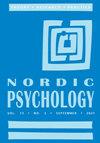The Operationalized Psychodynamic Diagnostic for Children and Adolescents (OPD-CA-2): a new diagnostic method to determine psychodynamic constructs
IF 1.1
4区 心理学
Q4 PSYCHOLOGY, MULTIDISCIPLINARY
引用次数: 0
Abstract
This special issue deals with a new diagnostic system, the Operationalized Psychodynamic Diagnostic for Children and Adolescents (OPD-CA-2). It has been an established instrument in the clinical context in German-speaking countries for several years. With the English version of the manual published in 2017, the Spanishand Turkish language version published in 2020 and 2021, the concept of operationalized psychodynamic diagnostics will spread even more widely internationally. We present in this special issue the initiatives and findings from contributors from Switzerland, Austria, Germany, Sweden and South America. The question of symptom diagnosis versus structure and conflict diagnosis currently occupies many therapists. The OPD-CA can be seen as a supplement to conventional diagnostics with the ICD-11 or the DSM-5. A symptom diagnosis can in no way be dispensed; it is the symptoms from which the patients and their families suffer and which ultimately lead to a diagnostic examination and, if necessary, to counseling, psychotherapeutic treatment or another indication. However, the mere determination of the symptoms is not sufficient for an efficient treatment, because symptoms can often change spontaneously or different symptoms occur simultaneously, so that a purely symptom-specific treatment may not be very effective. The Operationalized Psychodynamic Diagnostics in Childhood and Adolescence (OPD-CA) therefore strives for a complex recording of psychodynamic processes that caused the symptoms and embeds them in the developmental context. The development concept is central and affects all aspects of the process, from the type of findings to the selection of relevant diagnostic categories to the process of diagnostic assessment on various content-related axes and finally, a treatment recommendation.儿童和青少年操作性心理动力学诊断(OPD-CA-2):一种确定心理动力学结构的新诊断方法
本特刊涉及一种新的诊断系统,即儿童和青少年的操作性心理动力学诊断(OPD-CA-2)。多年来,它一直是德语国家临床上的一种既定工具。随着该手册的英文版于2017年出版,西班牙和土耳其语版于2020年和2021年出版,可操作的心理动力学诊断的概念将在国际上更广泛地传播。我们在本期特刊中介绍了来自瑞士、奥地利、德国、瑞典和南美洲的撰稿人提出的倡议和调查结果。症状诊断与结构和冲突诊断的问题目前占据了许多治疗师的位置。OPD-CA可以被视为ICD-11或DSM-5常规诊断的补充。症状诊断是不可能的;它是患者及其家人所遭受的症状,最终导致诊断检查,如有必要,还导致咨询、心理治疗或其他适应症。然而,仅仅确定症状不足以进行有效的治疗,因为症状通常会自发变化或同时出现不同的症状,因此纯粹的症状特异性治疗可能不是很有效。因此,儿童和青少年的操作性心理动力学诊断(OPD-CA)致力于对导致症状的心理动力学过程进行复杂的记录,并将其嵌入发展背景中。发展概念是核心,影响过程的各个方面,从发现的类型到相关诊断类别的选择,再到对各种内容相关轴的诊断评估过程,最后是治疗建议。
本文章由计算机程序翻译,如有差异,请以英文原文为准。
求助全文
约1分钟内获得全文
求助全文

 求助内容:
求助内容: 应助结果提醒方式:
应助结果提醒方式:


